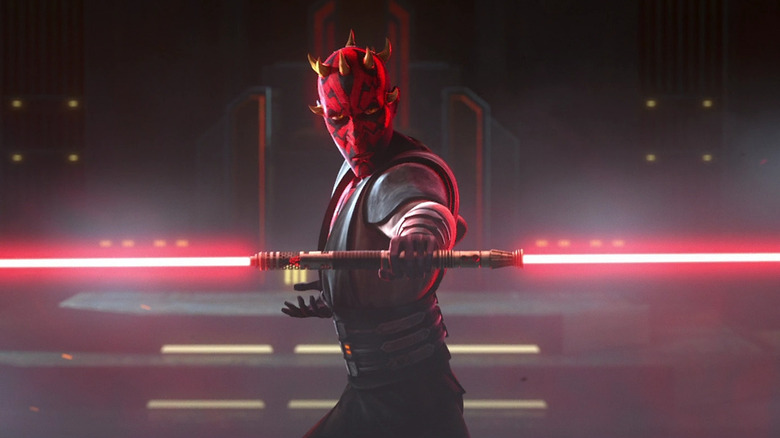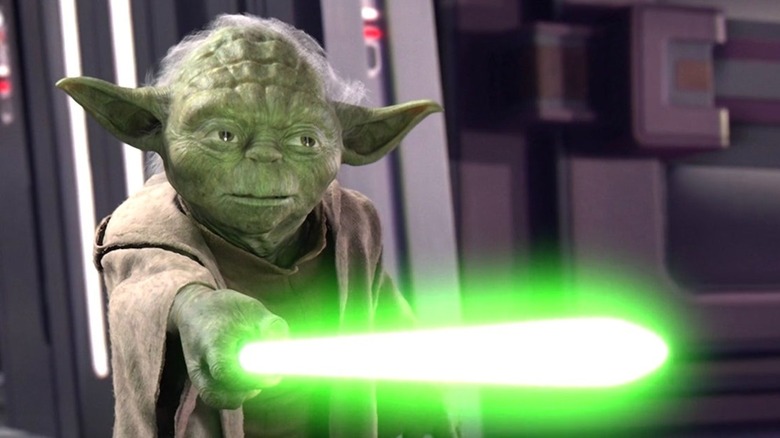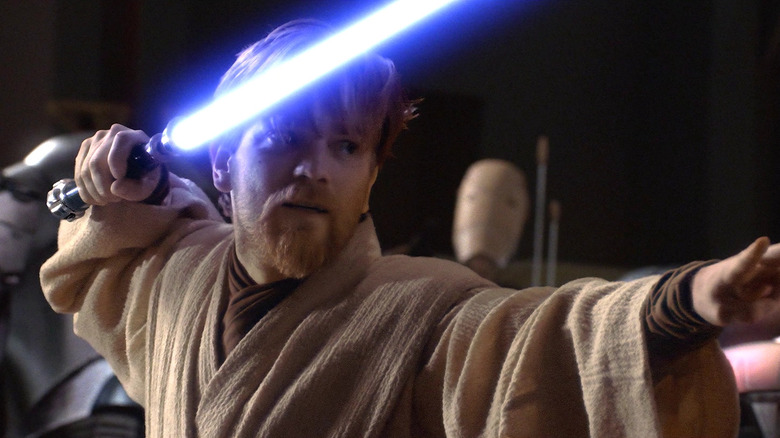Star Wars Lightsabers: Does Size Really Matter?
They say it's not the size of the dog in the fight, but the size of the fight in the dog that matters. But what about when that dog is a lightsaber? "Star Wars" has presented us with a bevy of laser swords over the decades — a veritable cavalcade of colors, hilts, fighting styles, and yes, sizes. But does the length of your laser really matter, or is it more about how you use it?
In the "Star Wars" parody universe of "Spaceballs," size clearly makes a difference. The tyrannical Dark Helmet (Rick Moranis) is impressed to discover that Lone Starr (Bill Pullman) has a "Schwartz" that measures up to his own. But we're not talking about some silly space wizard comedy. We're here to discuss a very serious and mature space wizard drama. There's a huge difference, just as there is between the various sizes of lightsabers.
On a business level, the reasoning for having so many different kinds of lightsabers is obvious: More models means more toys. But can we also glean some sense of the in-universe differences from the movies and shows? Does size really matter when it comes to the lightsabers of "Star Wars"?
The various sizes of lightsabers in Star Wars
Most lightsabers are comparable to each other in size. A standard hilt is usually a little shorter than a foot, and the blade when fully ignited typically reaches about three feet in length. Luke and Anakin Skywalker, Obi-Wan Kenobi, Mace Windu, Emperor Palpatine, and many other characters use this basic form factor. But then there are the divergences — the lightsabers that stray from, well, let's call it average size.
For all his wisdom and power in the Force, Yoda wields one of the smallest lightsabers ever — a two-foot blade with a hilt about half the size of a normal one. That makes sense, though, given his small stature. While lightsaber blades don't technically have weight, they are canonically quite heavy due to the immense amount of energy being poured through the kyber crystal. Yoda surely wouldn't have a problem commanding a larger lightsaber, but it would be cumbersome for him to use in a fight given how close to the ground he stands.
Other Jedi, like Ahsoka Tano, use smaller sabers called shoto blades, even though they're tall enough for full-size ones. Ahsoka uses hers as an offhand weapon while still wielding a longer saber in her main hand. The inner mechanics of a lightsaber allow the wielder to modify the length of the blade, though, so any Jedi can make changes in size according to their personal needs and preferences.
At the end of the day, lightsaber size is just a preference
You might take a look at the many losses of Darth Maul and the Imperial Inquisitors and assume that larger lightsabers like their double-bladed varieties are overly cumbersome and therefore unreliable. You might think that Yoda's short blade makes him less dangerous, or that he could have beaten Palpatine in "Revenge of the Sith" had he just had a few more inches. These are the kinds of debates that fandoms are built on. In reality, though, the size of a lightsaber doesn't really reflect anything other than personal preference.
There are many lightsaber fighting forms and styles, and while Jedi often train in several, most gravitate toward a particular form that aligns with their unique strengths. Darth Maul chose to use a double-bladed lightsaber and learned to fight according, just as Ahsoka and Asajj Ventress do with the two-saber style of Jar'Kai. Some styles and fighters might find themselves stronger or weaker against certain others, but that's more of a matchup issue than a reflection of the effectiveness of different sizes.
Some designs are simply flawed, like the spinning hilts of the Inquisitors, which are easy to disarm or break, but that's really a quality assurance issue, not a size thing. It's also worth noting that the length of the laser isn't the only thing that affects style. Count Dooku, for instance, has a blade of regular size but a curved hilt that allows for a specific kind of dueling. In the end, like so many things, it's not the size of your lightsaber but how you use it that makes the difference.


